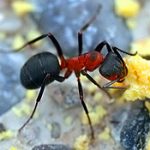Formica is a genus of ants. It is the type genus of the family Formicidae and the subfamily Formicinae, and in turn Formica’s own type species is the European red wood ant Formica rufa. Common names for this group are wood ant, mound ant, and field ant. Many of the better known forest species have common names that include the words “wood ant”, although F.rufa is also known as the “horse ant”. (However in German, the equivalent term Rossameise refers to the carpenter ants of the genus Camponotus.)
As the name wood ant implies, many Formica species live in wooded areas where there exists no shortage of material with which they can thatch their mounds. The most shade tolerant species are F. lugubris in Eurasia and F. subaenescens (fusca) in North America. However, sunlight is important to most Formica species, and colonies rarely survive for any considerable period in deeply shaded, dense woodland. The majority of species, especially outside the rufa species group, are inhabitants of more open woodlands or treeless grassland or shrubland. In North America, at least, these habitats had a long history of frequent landscape-scale fires that kept them open before European settlement. Conversion to agriculture and fire suppression have reduced the abundance of most American Formica, while the cessation of traditional haycutting seems to have had the same effect in Europe. However, at least a few Formica species may be found in a wide range of habitats from cities to seasides to grasslands to swamps to forests of the temperate Northern Hemisphere.
Mound building, forest dwelling Formica like F. rufa often have a considerable effect on their environment. They maintain large populations of aphids on whose secretions they feed, and the ants defend them from other predators. They also prey on other insects. In fact in many countries they are introduced in forests to control tree pests, such as swains jack pine sawfly and eastern tent caterpillars in North America. The effects of mound-building grassland species such as F. montana are not well-studied but their local abundance, conspicuous mound-building and very frequent association with aphids and membracids points to a comparably important ecological role.
Formica nests are of many different types from simple shaft-and-chamber excavations in soil with a small crater or turret of soil above to large mounds, under stones or logs, or in stumps. None are arboreal. The genus is abundant in both the Nearctic and Palearctic Regions. Due to their relatively large size and diurnal activity, they are among the more commonly seen ants in northern North America. There are many species of Formica (ITIS records nearly 200). Some species, including Formica rufa, which is common in Southern England, make large visible nests of dry plant stems, leaves, or conifer needles, usually based around a rotting stump. Wood ants typically secrete formic acid; F. rufa can squirt the acid from its acidopore several feet if alarmed, a habit which may have given rise to the archaic term for ant pismire, and by analogy its American equivalent piss-ant. They can be relatively large: F. rufa workers can reach a maximum length of around 10 mm. The eastern US species F. dolosa and the western F. ravida (=haemorrhoidalis) may reach slightly greater lengths. Formica are notable for their parasitic and slave making behaviors.

